Accessibility and Accommodations
Key Findings
- Mental health disorders and learning disabilities are the most common types of disabilities students report, with more female students than male students reporting having a mental health disorder.
- Nearly half of students with disabilities do not register with their institution's disability services office for support.
- One in three students with disabilities do not have positive responses to how their institution supports their need for accessible content and/or technology accommodations.
Actions You Can Take
- Utilize the Universal Design for Learning (UDL) framework when designing learning experiences and services to optimize learning for all people. Many students with disabilities choose not to register for disability services, and students age 18 and older have the right not to disclose even if they are eligible for support. If technology and IT policies are thoughtfully and inclusively incorporated into a course guided by UDL, then ideally learner variability, choice, and agency increase, while the need for individual accommodations is greatly reduced.
- Invest in professional development to better prepare faculty to implement accessible instruction, cultivate inclusive learning environments, understand the functional impact of specific disabilities on academic performance, and support accommodations requests.1 Michigan State's Broad College Faculty Accessibility Fellows program is one such initiative that supports faculty in designing learning environments that are as accessible as possible to all students.
- Expand access to mental health services for all students, and consider new strategies and tools that leverage technology-based interventions to provide new service access points for students. Online mental health outreach/referral services can offer support with less stigma and intimidation for students by way of mental health apps, websites, and videos, and wearable devices can allow learners to privately monitor their own behavior and stress levels.2
Peers You Can Connect With
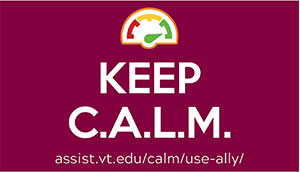
Keep C.A.L.M. and Use Ally
Virginia Tech
As a part of Virginia Tech's Keep C.A.L.M. (Choose Accessible Learning Materials) campaign, the institution has adopted the use of Ally within the Canvas LMS to help evaluate and ensure content accessibility. Previously, alternative content formats were made available only to students who chose to self-identify and register with the student disability office. Through Canvas, these alternative formats are available to all students, and between March and June of 2020 students had already downloaded more than 14,000 alternative formats of course materials.
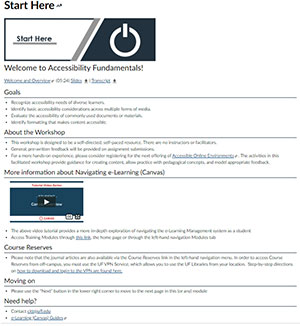
Accessibility Fundamentals: Removing Barriers
University of Florida
The University of Florida's Accessibility Fundamentals online workshop is designed as an introduction for university instructors and staff to accessibility needs and solutions in the classroom. The goals of the workshop are to help instructors and staff recognize the accessibility needs of diverse learners, identify basic accessibility considerations across multiple forms of media, evaluate the accessibility of commonly used documents or materials, and identify formatting that makes content accessible.
Mental Health Disorders and Learning Disabilities Are Prevalent
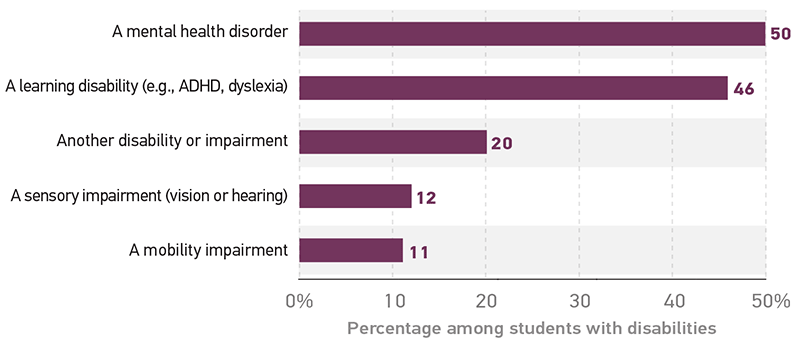
Mental health disorders and learning disabilities are the most common types of disabilities students report. Thirteen percent of the undergraduates in our study said that they had been diagnosed with a disability or impairment, and more students at community colleges (17%) said they have disabilities than non-CC students (12%). The most commonly reported type of disability is a mental health disorder, which half of students who reported a disability told us they have, and more women (54%) reported having mental health conditions than men (35%). Among respondents with a disability, almost half said they have a learning disability; significantly fewer (12%) reported sensory impairments (vision or hearing) and mobility disabilities (11%). Twenty percent told us they have a disability that was not listed in our survey—frequently listed disabilities are related to chronic illnesses (e.g., epilepsy, Type 1 Diabetes, autoimmune conditions, migraines) and autism spectrum disorder. Among those who reported having a disability, one-third (32%) said they have more than one type; among respondents with multiple disabilities, the most common types are learning disabilities (72%) and mental health disorders (82%).
Unregistered and Underserved
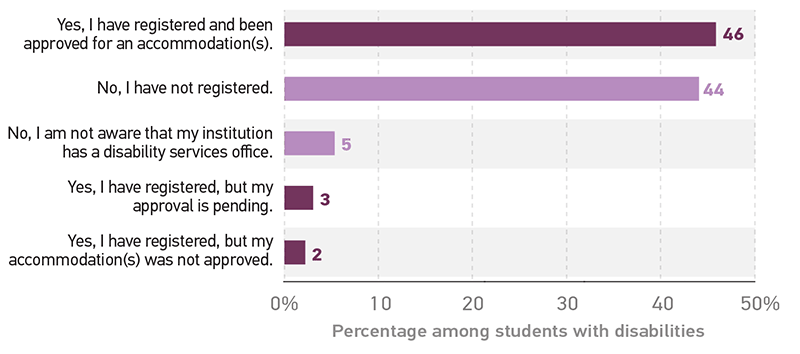
Nearly half of students with disabilities do not register with their institution's disability services office for support. While 46% of students with disabilities said they have registered and have been approved for accommodations, almost as many (44%) said they have not registered; another 5% were unaware that their institution even has a disability services office.3 Among students with disabilities, about a third (32%) said they require accessible content, accessible technologies, and/or technology accommodations for their coursework. Some of the most commonly cited reasons for not registering with disability services include not needing accommodations and that the services offered are not helpful (e.g., "My symptoms are currently managed well enough that I do not require any accommodations").4 Students also discussed how the stigma of disability keeps them from applying for services. Some respondents said they have "anxiety" about contacting the disability services office, are "uncomfortable" or "embarrassed," or are afraid of being turned away, not believed, or being labeled. Many students also told us that the process to apply for accommodations is "tedious and difficult," is "lengthy," and requires jumping through too many "hoops" for the limited accommodations they would get in return, if they even qualified at all. Students at most colleges must provide medical records of a recent diagnosis to qualify for services, and numerous respondents said this can create a financial burden. Other students reported that they don't know how to register, lack information on the services offered, or aren't aware services exist.
Not Making the Grade
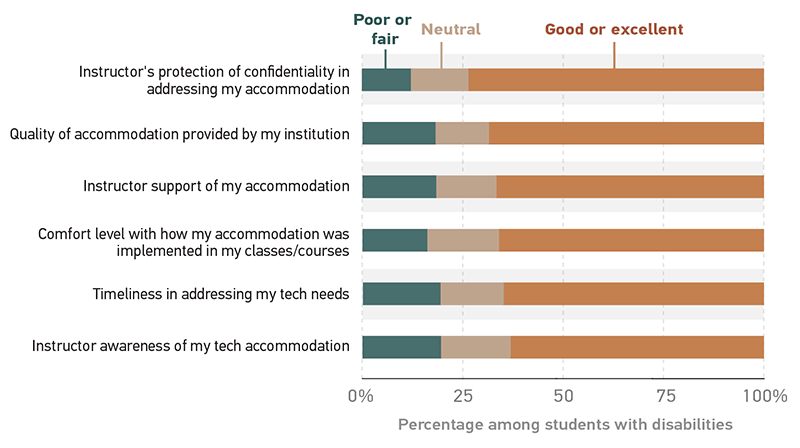
Many students with disabilities do not have positive responses to how their institution supported their need for accessible content and/or technology accommodations. Although the majority of those who need accessible and/or tech accommodations said their institution's approach is good or excellent, approximately one in three students with disabilities reported neutral or negative ratings for each of the items we asked about. Even the most favorably rated aspect of accommodation—the protection of confidentiality—received negative or neutral ratings from 27% of students. Poor/fair ratings were the highest for the categories of timeliness in addressing a technology accommodation5 and the instructor's awareness of a tech accommodation. Some respondents cited the difficult and/or lengthy process to apply for accommodations, as well as insufficient or limited resources at their institution's disability services office. Several students discussed challenges related to suitable technology and delays in getting the tech tools they need for their coursework. Meanwhile, of the students who responded to this question (n = 124), half cited difficulties working with their course instructors. These issues were discussed in terms of instructors' (1) lack of awareness or knowledge about following accommodation policy/directions; (2) lack of discretion in maintaining student privacy and confidentiality, and (3) reluctance or refusal to give students their approved accommodations. Many student comments suggest that some instructors are ignorant about the purpose of accommodations or are apathetic to or even disdainful of students who have different learning needs. Such attitudes and behaviors are discriminatory and put additional obstacles in the way of students who have specific needs that institutions are obligated to accommodate.
Notes
-
Feilin Hsiao, Sheryl Burgstahler, Terri Johnson, Daniel Nuss, Michael Doherty, "Promoting an Accessible Learning Environment for Students with Disabilities via Faculty Development," Journal of Postsecondary Education and Disability 32 no. 1 (Spring 2019): 91–99.
↩︎ -
Elizabeth Bradley and Michele Tugade, "Mental Health in Higher Education: Can a Digital Strategy Help?" EDUCAUSE Review, May 18, 2020; and Michelle Mullen, "Assistive Technology for Students with Mental Health Conditions," webinar, Association on Higher Education and Disability, April 28, 2020.
↩︎ -
Three percent reported they had registered with their campus disability services office and that their accommodation approval was pending; 2% reported that they had applied but their accommodation was not approved.
↩︎ -
Students who reported that they had not registered with their institution's disability services offices were asked in a follow-up open-response question to share details about why they chose not to.
↩︎ -
Failure to provide necessary accommodations in a timely manner has been upheld in lawsuits as discriminatory, and institutions can be held liable. For example, see Smith v. State University of New York, in Stephen B. Thomas, "College Students and Disability Law," LD Online.
↩︎